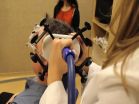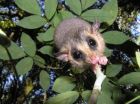(Press-News.org) The next time you get really mad, take a look in the mirror. See the lowered brow, the thinned lips and the flared nostrils? That's what social scientists call the "anger face," and it appears to be part of our basic biology as humans.
Now, researchers at UC Santa Barbara and at Griffith University in Australia have identified the functional advantages that caused the specific appearance of the anger face to evolve. Their findings appear in the current online edition of the journal Evolution and Human Behavior.
"The expression is cross-culturally universal, and even congenitally blind children make this same face without ever having seen one," said lead author Aaron Sell, a lecturer at the School of Criminology at Griffith University in Australia. Sell was formerly a postdoctoral scholar at UCSB's Center for Evolutionary Psychology.
The anger expression employs seven distinct muscle groups that contract in a highly stereotyped manner. The researchers sought to understand why evolution chose those particular muscle contractions to signal the emotional state of anger.
The current research is part of a larger set of studies that examine the evolutionary function of anger. "Our earlier research showed that anger evolved to motivate effective bargaining behavior during conflicts of interest," said Sell.
The greater the harm an individual can inflict, noted Leda Cosmides, the more bargaining power he or she wields. Cosmides, professor of psychology at UCSB, is a co-author on the study along with John Tooby, UCSB professor of anthropology. Cosmides and Tooby are co-directors of the campus's Center for Evolutionary Psychology.
"This general bargaining-through-menace principle applies to humans as well," said Tooby. "In earlier work we were able to confirm the predictions that stronger men anger more easily, fight more often, feel entitled to more unequal treatment, resolve conflicts more in their own favor and are even more in favor of military solutions than are physically weak men."
Starting from the hypothesis that anger is a bargaining emotion, the researchers reasoned that the first step is communicating to the other party that the anger-triggering event is not acceptable, and the conflict will not end until an implicit agreement is reached. This, they say, is why the emotion of anger has a facial expression associated with it. "But the anger face not only signals the onset of a conflict," said Sell. "Any distinctive facial display could do that. We hypothesized that the anger face evolved its specific form because it delivers something more for the expresser: Each element is designed to help intimidate others by making the angry individual appear more capable of delivering harm if not appeased."
For our ancestors, Cosmides noted, greater upper body strength led to a greater ability to inflict harm; so the hypothesis was that the anger face should make a person appear stronger.
Using computer-generated faces, the researchers demonstrated that each of the individual components of the anger face made those computer-generated people appear physically stronger. For example, the most common feature of the anger face is the lowered brow. Researchers took a computerized image of an average human face and then digitally morphed it in two ways: One photo showed a lowered brow, and the other a raised brow. "With just this one difference, neither face appeared 'angry,' " said Sell. "But when these two faces were shown to subjects, they reported the lowered brow face as looking like it belonged to a physically stronger man."
The experiment was repeated one-by-one with each of the other major components of the classic anger face — raised cheekbones (as in a snarl), lips thinned and pushed out, the mouth raised (as in defiance), the nose flared and the chin pushed out and up. As predicted, the presence by itself of any one of these muscle contractions led observers to judge that the person making the face was physically stronger.
"Our previous research showed that humans are exceptionally good at assessing fighting ability just by looking at someone's face," said Sell. "Since people who are judged to be stronger tend to get their way more often, other things being equal, the researchers concluded that the explanation for evolution of the form of the human anger face is surprisingly simple — it is a threat display."
These threat displays — like those of other animals — consist of exaggerations of cues of fighting ability, Sell continued. "So a man will puff up his chest, stand tall and morph his face to make himself appear stronger.
"The function of the anger face is intimidation," added Cosmides, "just like a frog will puff itself up or a baboon will display its canines."
As Tooby explained, "This makes sense of why evolution selected this particular facial display to co-occur with the onset of anger. Anger is triggered by the refusal to accept the situation, and the face immediately organizes itself to advertise to the other party the costs of not making the situation more acceptable. What is most pleasing about these results is that no feature of the anger face appears to be arbitrary; they all deliver the same message."
According to Sell, the researchers know this to be true because each of the seven components has the same effect. "In the final analysis, you can think of the anger face as a constellation of features, each of which makes you appear physically more formidable."
INFORMATION: END
The universal 'anger face'
Researchers at UCSB and Griffith University in Australia identify origin and purpose of the facial expression for anger
2014-08-28
ELSE PRESS RELEASES FROM THIS DATE:
Climate change puts endangered Devils Hole pupfish at risk of extinction
2014-08-28
RENO, Nev. – Climate change is hurting reproduction of the endangered Devils Hole pupfish, threatening the survival of this rare species that has numbered as few as 35 individuals, new research by the University of Nevada, Reno and Desert Research Institute shows.
Scientists report that geothermal water on a small shelf near the surface of an isolated cavern in the Nevada desert where the pupfish live is heating up as a result of climate change and is likely to continue heating to dangerous levels.
The hotter water, which now reaches more than 93 degrees, has shortened ...
Deadly remedy: Warning issued about Chinese herbal medicine
2014-08-28
A herbal preparation prescribed by a Chinese herbal medication practitioner in Melbourne for back pain resulted in life-threatening heart changes, prompting a team of intensive care and emergency physicians to call for appropriate patient education by practitioners who prescribe complementary medications.
Writing in Emergency Medicine Australasia, the journal of the Australasian College for Emergency Medicine, emergency medicine trainees Dr Angelly Martinez and Dr Nicky Dobos from the Intensive Care Unit at the Royal Melbourne Hospital and emergency medicine trainee Dr ...
Are cigarette substitutes a safe alternative? It depends on user habits
2014-08-28
CORAL GABLES, Fla (Aug. 26, 2014)-- Cigarette smoking kills approximately 440,000 Americans each year, according to the Centers for Disease Control and Protection. It's the leading cause of preventable death worldwide. In order to overcome this addiction, many people resort to nicotine replacement therapies.
A recent literature review study by researchers at the University of Miami (UM) suggest that small dosages of nicotine found in cigarette substitutes could be harmful to human musculoskeletal system, due to overuse. The findings are reported in the Global Journal ...
From bite site to brain: How rabies virus hijacks and speeds up transport in nerve cells
2014-08-28
Rabies (and rabies virus, its causative agent) is usually transmitted through the bite of an infected animal into muscle tissue of the new host. From there, the virus travels all the way to the brain where it multiplies and causes the usually fatal disease. An article published on August 28th in PLOS Pathogens sheds light on how the virus hijacks the transport system in nerve cells to reach the brain with maximal speed and efficiency.
Pathogens that travel in the blood can spread throughout the body without much effort, courtesy of the heart's pumping action. Those traveling ...
Genomic sequencing reveals mutations, insights into 2014 Ebola outbreak
2014-08-28
In response to an ongoing, unprecedented outbreak of Ebola virus disease (EVD) in West Africa, a team of researchers from the Broad Institute and Harvard University, in collaboration with the Sierra Leone Ministry of Health and Sanitation and researchers across institutions and continents, has rapidly sequenced and analyzed more than 99 Ebola virus genomes. Their findings could have important implications for rapid field diagnostic tests. The team reports its results online in the journal Science.
For the current study, researchers sequenced 99 Ebola virus genomes collected ...
Radio telescopes settle controversy over distance to Pleiades
2014-08-28
Astronomers have used a worldwide network of radio telescopes to resolve a controversy over the distance to a famous star cluster -- a controversy that posed a potential challenge to scientists' basic understanding of how stars form and evolve. The new work shows that the measurement made by a cosmic-mapping research satellite was wrong.
The astronomers studied the Pleiades, the famous "Seven Sisters" star cluster in the constellation Taurus, easily seen in the winter sky. The cluster includes hundreds of young, hot stars formed about 100 million years ago. As a nearby ...
New research reveals how wild rabbits were genetically transformed into tame rabbits
2014-08-28
The genetic changes that transformed wild animals into domesticated forms have long been a mystery. An international team of scientists has now made a breakthrough by showing that many genes controlling the development of the brain and the nervous system were particularly important for rabbit domestication. The study is published today in Science and gives answers to many genetic questions.
The domestication of animals and plants, a prerequisite for the development of agriculture, is one of the most important technological revolutions during human history. Domestication ...
Electric current to brain boosts memory
2014-08-28
VIDEO:
Stimulating a region in the brain with non-invasive electrical current using magnetic pulses (Transcranial Magnetic Stimulation) improves memory, reports a new Northwestern Medicine study in Science. The discovery opens...
Click here for more information.
CHICAGO --- Stimulating a particular region in the brain via non-invasive delivery of electrical current using magnetic pulses, called Transcranial Magnetic Stimulation, improves memory, reports a new Northwestern Medicine® ...
Less than $200 million would conserve precious Atlantic Forest in Brazil, say researchers
2014-08-28
Brazil could conserve its valuable Atlantic Forest by investing just 0.01 per cent of its annual GDP, according to a new study.
The Atlantic Forest (Mata Atlântica) is one of the most important and threatened biodiversity hotspots in the world, containing the only living examples of nearly 10,000 species of plant and more bird species than all of Europe.
Situated along the Atlantic coast of Brazil, it once covered an area of nearly 1.5 million square kilometres. Today, the forest is home to more than 130 million people and it covers only 160,000 km2, because of deforestation. ...
Home is where the microbes are
2014-08-28
A person's home is their castle, and they populate it with their own subjects: millions and millions of bacteria.
A study published today in Science provides a detailed analysis of the microbes that live in houses and apartments. The study was conducted by researchers from the U.S. Department of Energy's Argonne National Laboratory and the University of Chicago.
The results shed light on the complicated interaction between humans and the microbes that live on and around us. Mounting evidence suggests that these microscopic, teeming communities play a role in human ...
LAST 30 PRESS RELEASES:
Enriching framework Al sites in 8-membered rings of Cu-SSZ-39 zeolite to enhance low-temperature ammonia selective catalytic reduction performance
AI-powered RNA drug development: a new frontier in therapeutics
Decoupling the HOR enhancement on PtRu: Dynamically matching interfacial water to reaction coordinates
Sulfur isn’t poisonous when it synergistically acts with phosphine in olefins hydroformylation
URI researchers uncover molecular mechanisms behind speciation in corals
Chitin based carbon aerogel offers a cleaner way to store thermal energy
Tracing hidden sources of nitrate pollution in rapidly changing rural urban landscapes
Viruses on plastic pollution may quietly accelerate the spread of antibiotic resistance
Three UH Rainbow Babies & Children’s faculty elected to prestigious American Pediatric Society
Tunnel resilience models unveiled to aid post-earthquake recovery
Satellite communication systems: the future of 5G/6G connectivity
Space computing power networks: a new frontier for satellite technologies
Experiments advance potential of protein that makes hydrogen sulfide as a therapeutic target for Alzheimer’s disease
Examining private equity’s role in fertility care
Current Molecular Pharmacology achieves a landmark: real-time CiteScore advances to 7.2
Skeletal muscle epigenetic clocks developed using postmortem tissue from an Asian population
Estimating unemployment rates with social media data
Climate policies can backfire by eroding “green” values, study finds
Too much screen time too soon? A*STAR study links infant screen exposure to brain changes and teen anxiety
Global psychiatry mourns Professor Dan Stein, visionary who transformed mental health science across Africa and beyond
KIST develops eco-friendly palladium recovery technology to safeguard resource security
Statins significantly reduce mortality risk for adults with diabetes, regardless of cardiovascular risk
Brain immune cells may drive more damage in females than males with Alzheimer’s
Evidence-based recommendations empower clinicians to manage epilepsy in pregnancy
Fungus turns bark beetles’ defenses against them
There are new antivirals being tested for herpesviruses. Scientists now know how they work
CDI scientist, colleagues author review of global burden of fungus Candida auris
How does stroke influence speech comprehension?
B cells transiently unlock their plasticity, risking lymphoma development
Advanced AI dodel predicts spoken language outcomes in deaf children after cochlear implants
[Press-News.org] The universal 'anger face'Researchers at UCSB and Griffith University in Australia identify origin and purpose of the facial expression for anger






